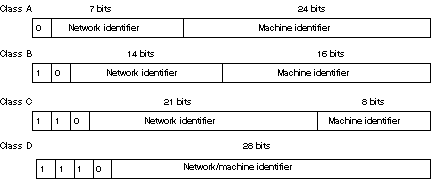Each device connected to the network should have a unique IP address.
When the type of network environment is open, the uniqueness of the address is guaranteed by the authorized organism in the country where the network is located by assigning it a network identifier.
If the type of environment is closed, the uniqueness of the address is managed by the company's network manager.
The TSX ETY 4103/PORT/5103 modules and the Ethernet link of the TSX P57 6634/5634/4634 can have their address dynamically allocated by an address server or have their address configured by the user.
This address is made up of two identifiers, one of which identifies the network, the other identifies the connected machine.
An IP address is defined on 32 bits. It is made up from 4 decimal numbers, each coded on a byte (example: 140.186.90.3).
Depending on the network span, four address classes can be used:
-
Class A applies to large span networks, which have a large number of connected stations.
-
Class B applies to medium span networks, which have fewer connected stations.
-
Class C applies to small span networks, which have few connected stations.
-
Class D is used for multicast. A class D address must not be allocated to a module.
Depending on the class, an address is structured in the following way:
The following table displays the spaces reserved for the different IP address classes:
|
Class
|
Range
|
|
A
|
0.0.0.0 to 127.255.255.255
|
|
B
|
128.0.0.0 to 191.255.255.255
|
|
C
|
192.0.0.0 to 223.255.255.255
|
|
D
|
224.0.0.0 to 239.255.255.255
|
